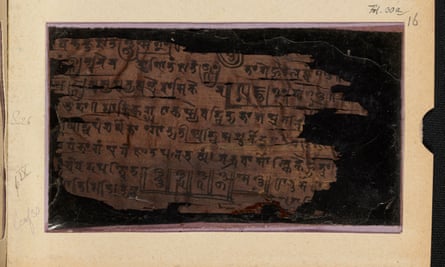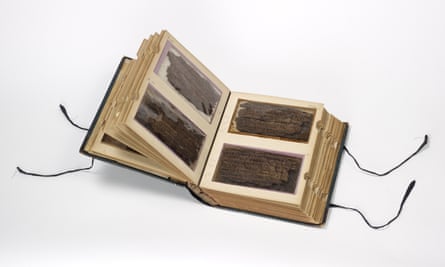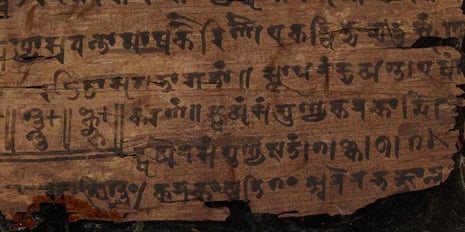Nowt, nada, zilch: there is nothing new about nothingness. But the moment that the absence of stuff became zero, a number in its own right, is regarded as one of the greatest breakthroughs in the history of mathematics.
Now scientists have traced the origins of this conceptual leap to an ancient Indian text, known as the Bakhshali manuscript – a text which has been housed in the UK since 1902.
Radiocarbon dating reveals the fragmentary text, which is inscribed on 70 pieces of birch bark and contains hundreds of zeroes, dates to as early as the 3rd or 4th century – about 500 years older than scholars previously believed. This makes it the world’s oldest recorded origin of the zero symbol that we use today.

Marcus du Sautoy, professor of mathematics at the University of Oxford, said: “Today we take it for granted that the concept of zero is used across the globe and our whole digital world is based on nothing or something. But there was a moment when there wasn’t this number.”
The Bakhshali manuscript was found in 1881, buried in a field in a village called Bakhshali, near Peshawar, in what is now a region of Pakistan. It was discovered by a local farmer and later acquired by the Bodleian Library in Oxford.
Translations of the text, which is written in a form of Sanskrit, suggest it was a form of training manual for merchants trading across the Silk Road, and it includes practical arithmetic exercises and something approaching algebra. “There’s a lot of ‘If someone buys this and sells this how much have they got left?’” said Du Sautoy.
In the fragile document, zero does not yet feature as a number in its own right, but as a placeholder in a number system, just as the “0” in “101” indicates no tens. It features a problem to which the answer is zero, but here the answer is left blank.
Several ancient cultures independently came up with similar placeholder symbols. The Babylonians used a double wedge for nothing as part of cuneiform symbols dating back 5,000 years, while the Mayans used a shell to denote absence in their complex calendar system.
However the dot symbol in the Bakhshali script is the one that ultimately evolved into the hollow-centred version of the symbol that we use today. It also sowed the seed for zero as a number, which is first described in a text called Brahmasphutasiddhanta, written by the Indian astronomer and mathematician Brahmagupta in 628AD.
“This becomes the birth of the concept of zero in it’s own right and this is a total revolution that happens out of India,” said Du Sautoy.
The development of zero as a mathematical concept may have been inspired by the region’s long philosophical tradition of contemplating the void and may explain why the concept took so long to catch on in Europe, which lacked the same cultural reference points.
“This is coming out of a culture that is quite happy to conceive of the void, to conceive of the infinite,” said Du Sautoy. “That is exciting to recognise, that culture is important in making big mathematical breakthroughs.”
Despite developing sophisticated maths and geometry, the ancient Greeks had no symbol for zero, for instance, showing that while the concept zero may now feel familiar, it is not an obvious one.
“The Europeans, even when it was introduced to them, were like ‘Why would we need a number for nothing?’” said Du Sautoy. “It’s a very abstract leap.”

In the latest study, three samples were extracted from the manuscript and analysed at the Oxford Radiocarbon Accelerator Unit. The results revealed that the three samples tested date from three different centuries, one from 224-383 AD, another from 680-779 AD and another from 885-993 AD, raising further questions about how the manuscript came to be packaged together as a single document.
The development of zero in mathematics underpins an incredible range of further work, including the notion of infinity, the modern notion of the vacuum in quantum physics, and some of the deepest questions in cosmology of how the Universe arose – and how it might disappear from existence in some unimaginable future scenario.
Richard Ovenden, head of the Bodleian Library, said the results highlight a Western bias that has often seen the contributions of South Asian scholars being overlooked. “These surprising research results testify to the subcontinent’s rich and longstanding scientific tradition,” he said.
The manuscript will be on public display on 4 October, as part of a major exhibition, Illuminating India: 5000 Years of Science and Innovation, at the Science Museum in London.

Comments (…)
Sign in or create your Guardian account to join the discussion